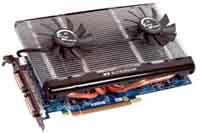And is the card AGP or PCIe slot compatible? Do I still get first dibs ?

:D
What are you waiting for, Put it in, here's how:
You will need to go into the bios BEFORE you install the new AGP card, change the BIOS setting for primary graphics display to "expansion slot" , "AGP Slot" , "AUTO" or whatever logical switch is there to switch to the new card, reboot and wait at least 30 seconds, if by then you see no image on the screen, power off the PC by holding down the "on" switch for 4 seconds or turning the power off. {Some PC's may still show an image on each display device adapter, despite the BIOS switch setting, in that event, shut down the PC with no further action.}
Next, unplug the PC, carefully install the new card into the AGP slot taking care not to break the plastic retaining clip on the end of the slot. Make sure it is seated correctly and everything looks aligned and perfect.
Screw the retaining screw into the top of the metal bracket on the card. Rob one from some other position on the case if needed.
Take the monitor cord out of the mainboard connector, (unscrew it first or damage may occur), and carefully screw it into the new card's monitor outlet using the finger screws.
Plug in the power to the PC, turn it on and windows will try to install drivers, cancel the driver load.
Place the driver disk supplied with the new card into the CDROM drive, and run the driver setup routine, don't worry about installing the other junk yet.
Start geeking about with graphics applications like FS9, (which, incidently may crash on startup because the fs9.cfg file is now not recognising your new card), and come back here for help if needed.
Once the card is up and running, you can go to
www.guru3d.com and to the Forceware drivers section for the latest WHQL approved drivers, but make sure you check out the readmes before you download, to make sure it's for your card.





 Mainboard: Asus P5K-Premium, CPU=Intel E6850 @ x8x450fsb 3.6ghz, RAM: 4gb PC8500 Team Dark, Video: NV8800GT, HDD: 2x1Tb Samsung F3 RAID-0 + 1Tb F3, PSU: Antec 550 Basiq, OS: Win7x64, Display: 24&
Mainboard: Asus P5K-Premium, CPU=Intel E6850 @ x8x450fsb 3.6ghz, RAM: 4gb PC8500 Team Dark, Video: NV8800GT, HDD: 2x1Tb Samsung F3 RAID-0 + 1Tb F3, PSU: Antec 550 Basiq, OS: Win7x64, Display: 24&


 :D
:D